Bote EasyRider Aero’ iSUP Review
Pros
- Heaps of stability
- Always nice to have an eye-catching board!
- Love the all-over deck pad
- Super comfortable kayak seat
- Pleasingly light and easy to carry
Cons
- Slightly lacking in fittings compared to the competition
- Kayak mode would be even better with a footrest
- You’ll probably want to upgrade the paddle
Bote’s budget offering in the hybrid market is light, stable and user friendly in either SUP or kayak mode, and comes in at a very respectable price…
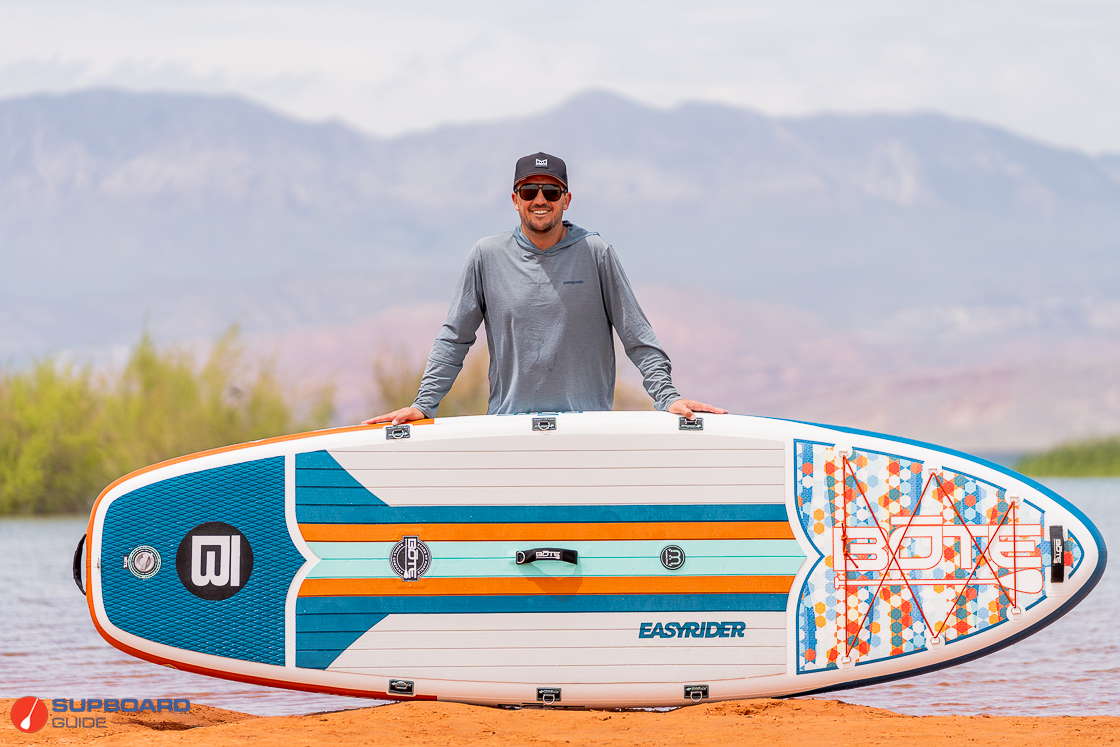
SUP/kayak hybrids are all the rage now, and Bote’s EasyRider Aero 10’4 is another worthy addition to the line-up. (The ‘Native Tides’ in the title refers to the color scheme; a theme throughout the Bote range, each model having its own distinctive look).
The EasyRider Aero 10’4 is all about stability. Its generous 36” of width means that it’s never going to be particularly quick or nimble, it’s much more about simply being an extremely user friendly platform in either SUP or kayak mode.
We think the Bote EasyRider Aero 10’4 would be a great SUP for paddlers who:
- Like the SUP/kayak combo concept
- Want a big easy stable platform (for either activity)
- Love a classy yet colorful look to their board
- Appreciate a board that is light and easy to carry.
Bote EasyRider Aero 10’4: Spec Sheet
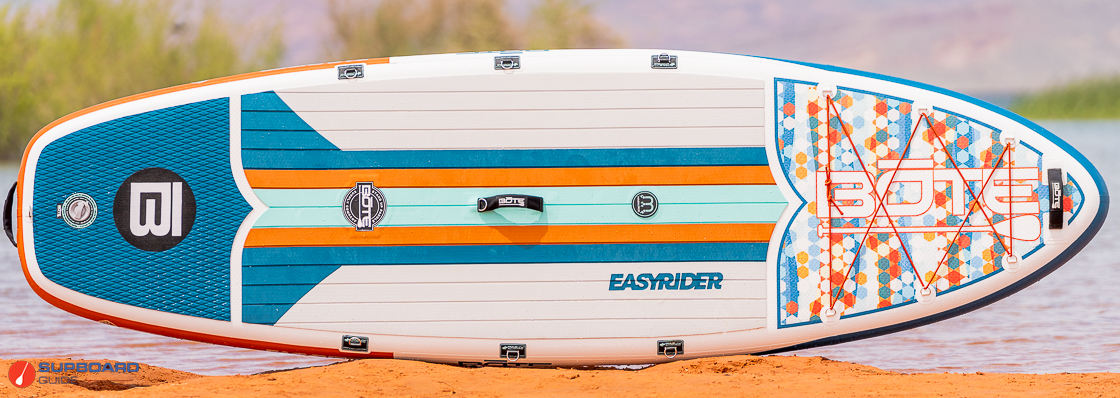
- Board Category: SUP/Kayak Hybrid
- Listed Board Dimensions: 10′4″ L × 36″ W × 6″ D
- Measured Board Dimensions: 10′4″ L × 36″ W × 6″ D
- Listed Board Weight: 28 lbs
- Actual Board Weight (board only, not inflated): 19.6 lbs
- Listed Max Capacity: 250 lbs
- Recommended PSI: 10-15 PSI
- Fins: 10” ‘aero’ center fin
- Paddle: 4-Piece Aluminum SUP+Kayak Hybrid Paddle
- Board Shell Construction Materials: Single layer PVC
- Drop-stitch type: Knitted
- Price Range: $649
- Warranty: limited 2 year warranty
Performance Review of the Bote EasyRider Aero 10’4 Stand Up Paddle Board
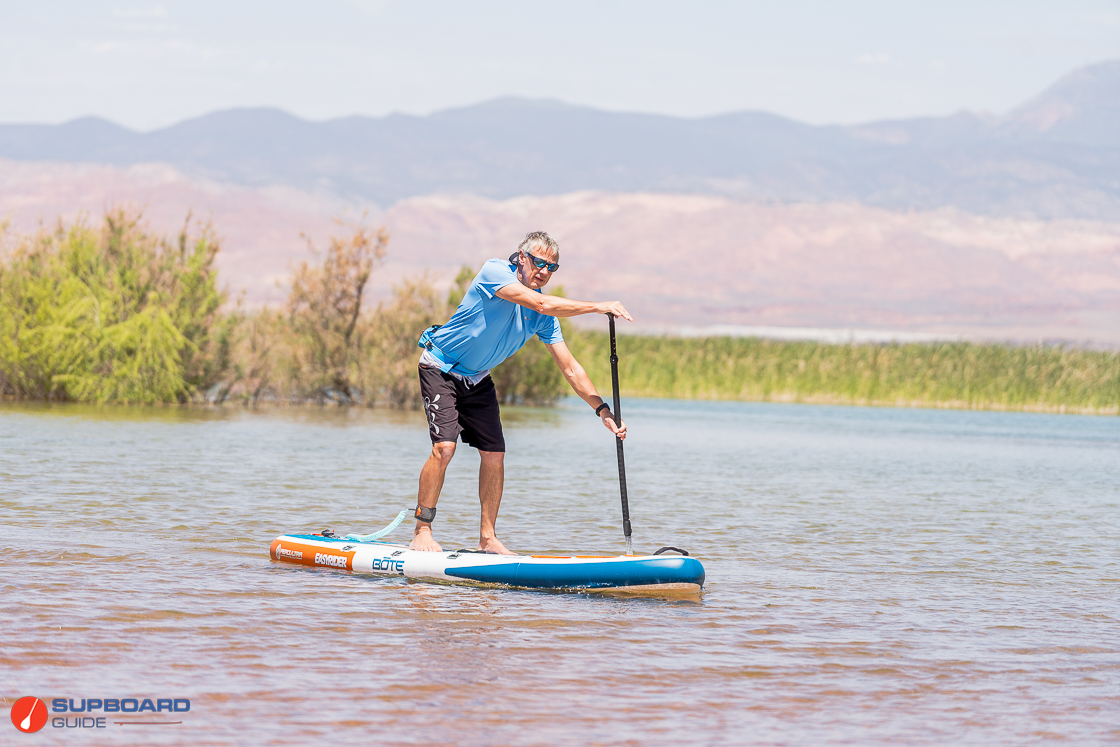
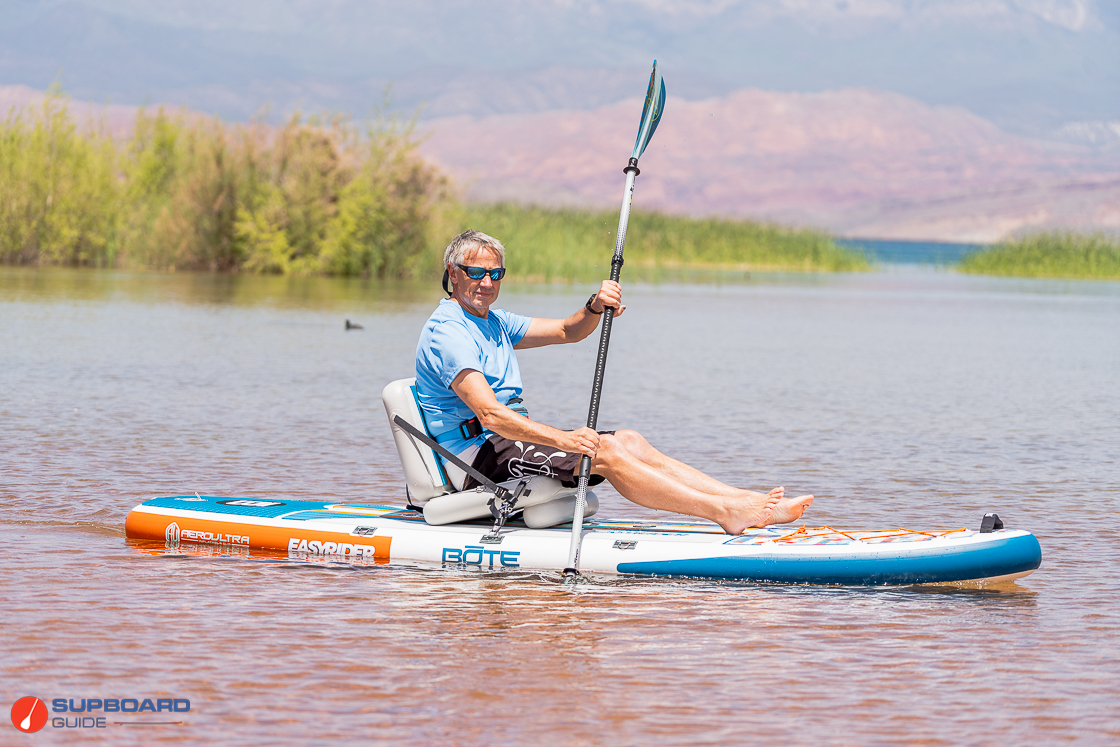
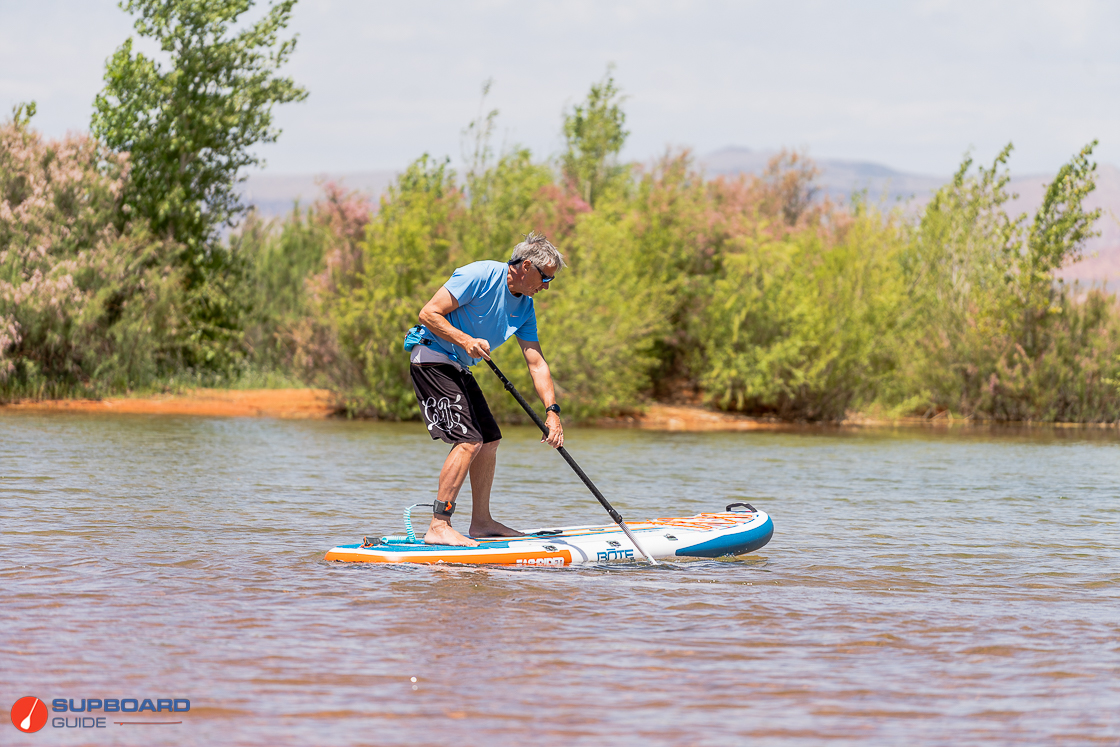
Overall Score: 9.0/10
- Stability: 9.2/10
- Speed: 8.0/10
- Tracking: 8.9/10
- Maneuverability: 8.6/10
- Construction Quality: 8.5/10
- Features/Accessories: 8.7/10
Stability Rating: 9.2/10
So we’re starting the performance review with the characteristic that really defines the Bote EasyRider Aero.
It’s a classic proof of the fact that paddleboards do not need to be long to be stable, but they do need to be wide. The EasyRider Aero is extremely wide, 36” at the widest point; that’s pretty much as wide as regular paddleboards get.
And sure enough, this is one seriously stable machine! It’s not only wide but it also holds a whole lot of width through much of its length, particularly back in the tail, which gives the board a stack of primary and secondary stability, aided even further by the very large surface area of fin under the tail.
All this stability also means that the board has very good weight carrying capacity. Normally, we tend to scoff at the ‘maximum weight capacity’ numbers that brands assign to their boards, as they’re usually pretty meaningless. However, we think Bote has pretty much got it bang on in giving this board a 250 lbs max weight capacity. That would be our exact recommendation for maximum rider weight. And actually, the only reason you wouldn’t want to go much heavier is not so much because the board doesn’t have the stability to cope with it, but because the slightly higher degree of flex in the board due to its single skin construction comes into play if all the weight is concentrated at one point (as happens when a rider stands on the board). Whereas a lighter rider, let’s say 180 lbs, could probably get away with carrying an additional 120 lbs or more of cargo, spread around the nose and tail.
Speed Test: 8.0/10
| Board | |
| Sprint Speed: | 4.9 MPH |
| Average Cruising Speed: | 3.5 MPH |
To obtain our speed test results, we use a Speed Coach SUP 2 device from NK Sports. This gives us accurate real-time readings on how fast we are paddling and our stroke rates. For the top sprint speed, we paddle as hard as we can for approximately 10-15 seconds and then record our average speed. For the casual test, we paddle at 35-40 strokes per minute for approximately 30-60 seconds and record the average speed.
No one should be buying a 36” wide board with anticipation that it’s going to be a race winner. Indeed, when the board is literally called ‘Easy Rider’, you kinda know that you’re not getting on some super speed machine! So we didn’t have any great expectations of amazing results in this department. Indeed, we were quite prepared for some fairly unimpressive numbers in our speed tests.


Fortunately, the Aero 10’4 does have one parameter working very much in its favor in this aspect of performance; its light weight. While the speed results we achieved were nothing special, they were certainly no worse than most other boards of this size, and the light weight does mean that the board still feels reasonably lively, even if it isn’t breaking speed records. For general cruising, when speed is not a priority, the board trucks along very nicely at a cool 3.5 mph. You’re aware of the width (particularly if you’re much shorter than 6’) which does make it harder to get the paddle at a good vertical angle, but the board doesn’t feel too draggy or slow.
When you try and push the board along at a faster pace, the extra flex of the single skin construction starts to be felt, particularly noticeable for our heavier riders. The board really isn’t that interested in being asked to go at high speeds. We could push it along at nearly 5 mph if we really worked hard, but it was no kind of fun – this is not what the board is built to do.
In kayak mode, the board moves across the water very comfortably, and the flex issue is much less noticeable as your weight is more evenly distributed across the board. The lack of a footrest becomes an issue if you are trying to paddle fast for any sustained period of time, as you can’t use your lower body to brace and power up your stroke. However, while we didn’t get around to exploring the possibility, it should be possible to rig something up using the front carry strap connectors and rearmost bungee fixings, and we’d certainly recommend exploring this possibility, since it would raise the performance and comfort in the kayak mode considerably.
Tracking: 8.8/10
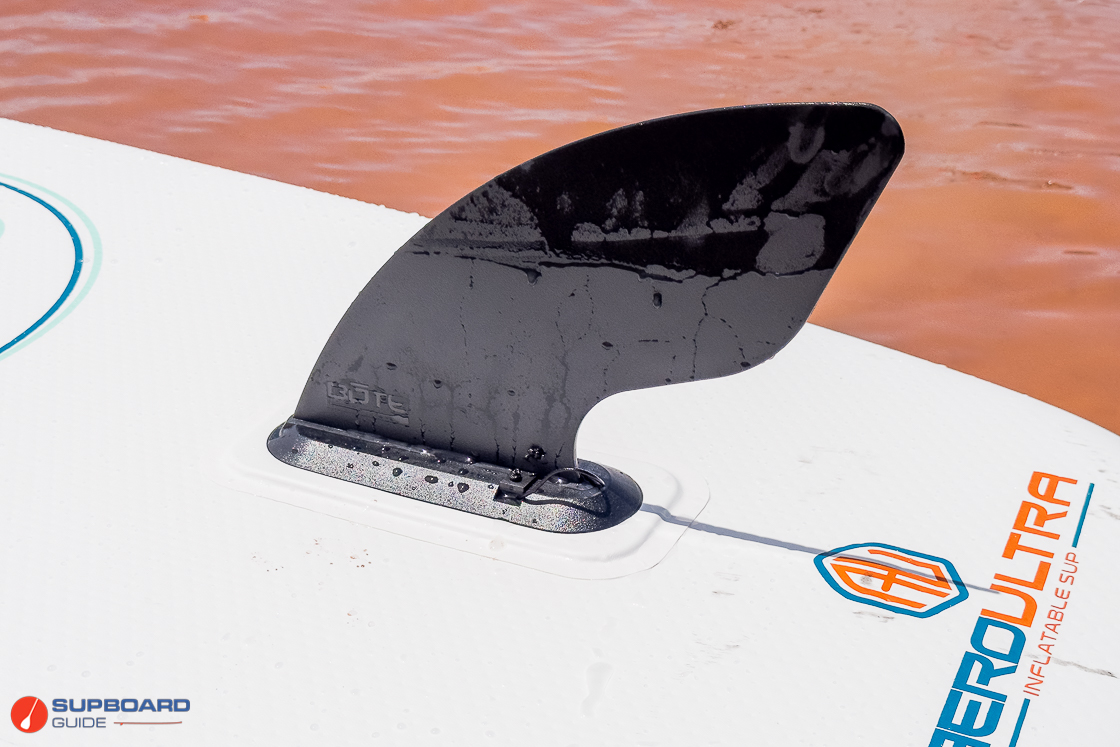

Tracking is another area where the Bote EasyRider Aero 10’4s performance doesn’t necessarily match up with expectations. Looking at that bullet-like plan shape, with the width extending a long way back, along with the touring-style pointed nose, one would certainly expect the board to hold pretty well to its course.
On the other hand though, it’s quite short, which doesn’t help with directional stability, and as already discussed it’s a whopping 36” wide. The unavoidable consequence of so much width is that – however good your technique may be – your paddle blade is working a long way from the centerline of the board, which makes every stroke more of a turning stroke.It’s also a whole lot more effort for shorter paddlers to get the paddle shaft relatively upright, as discussed in the previous section.
So, what did we find? Well, it turns out that the EasyRider Aero 10’4 actually tracks reasonably well. The plus points from the plan shape and the minus points from the width sort of cancel each other out to a large degree, and the factor that ends up swinging the result to the positive is the massive fin under the tail. It has a huge area, indeed it’s more like a keel than a fin, and it really helps hold the board on course.
Overall therefore, we can award a reasonably good score for the tracking performance, in relation to other boards of this size and style. Obviously in the greater scheme of things, it’s never going to track as well as a longer, narrower touring board. But it’s actually not bad at all for something so short and wide.
The tracking in kayak mode is very good, it’ll hold its line for as long as you want it to.
Maneuverability: 8.6/10
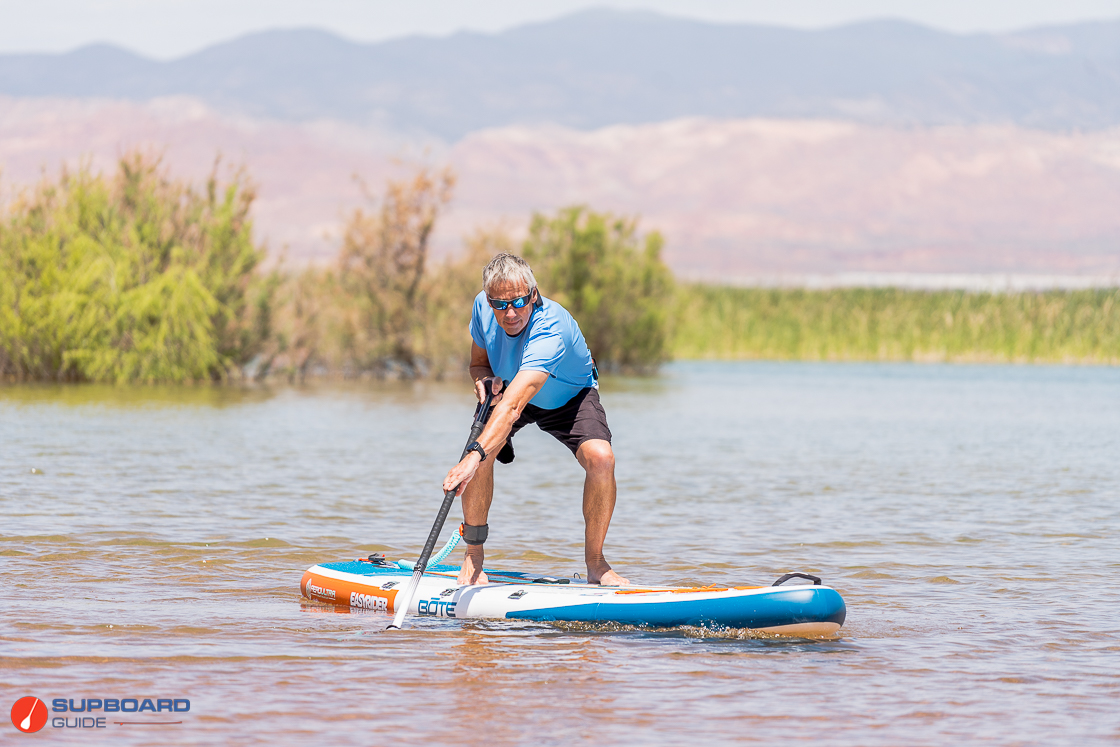
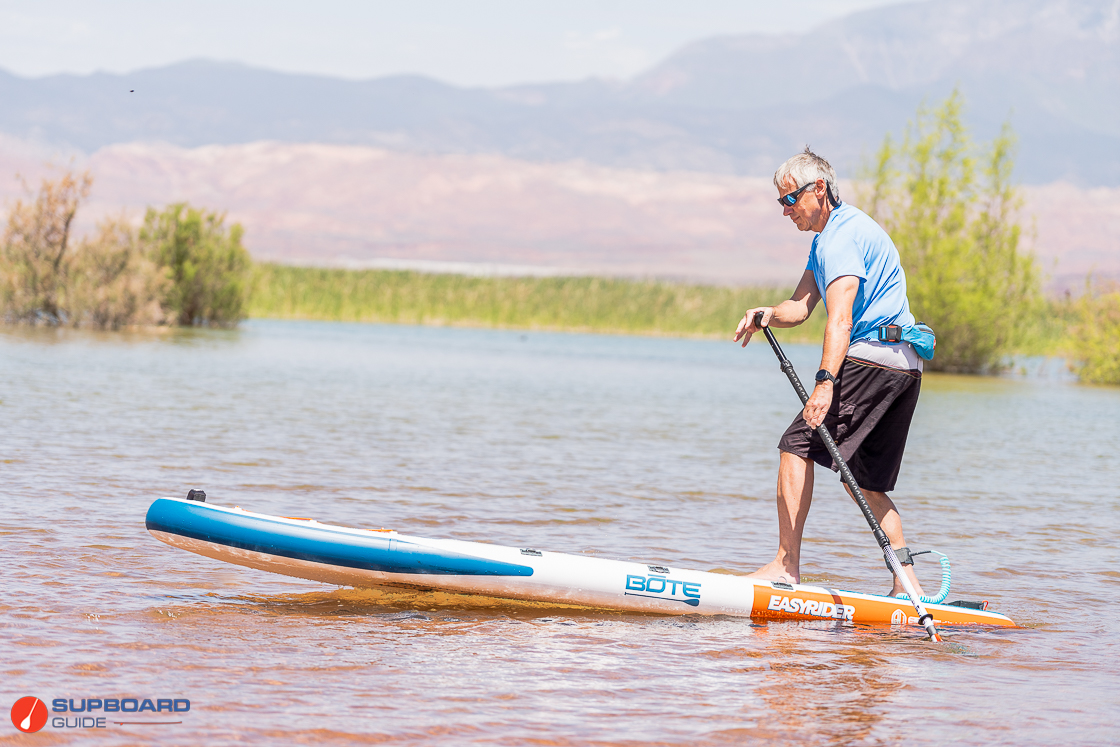
This is yet another interesting one to try and quantify, because the Bote EasyRider Aero 10’4 design has all sorts of conflicting aspirations when it comes to maneuvering.
For starters, it’s a single-fin board. Now, single-finners are normally easier to turn, but the huge fin that the Bote comes with does its best to lock you on course, even though it’s quite swept back.
Then there’s the plan shape. Those parallel sides and the wide tail are design characteristics generally associated with good straight line tracking, as discussed in the previous section. So you wouldn’t necessarily expect the EasyRider Aero 10’4 to be particularly pivotal. Yet because it is both relatively short and extremely wide, it is actually surprisingly easy to change direction using standard paddle turning techniques such as sweep strokes or draw strokes. (If you want to learn more about how to turn boards like this do check out our turning technique video on youtube.).
The light construction also really helps in this respect as it makes the board feel more responsive. And of course, that huge fat square tail makes getting back for pivot turns super easy and safe-feeling.
So, all in all, we’re happy to give the EasyRider Aero 10’4 a reasonably good score for maneuvering. Obviously you’re not buying a board like this to go surfing in waves, that sort of hard turning is absolutely not what it’s designed for. But it’s certainly not ‘locked in’ like a longer touring or racing board is, and it’ll be a particularly fun board for learning tail-sink turning techniques.
In kayak mode, the EasyRider Aero 10’4 is more straight-line than throwabout in feel. It’s actually quite reluctant to turn, and because it’s so stable you can’t easily lean into the turns as you would with a proper kayak.
Construction Quality: 8.5/10
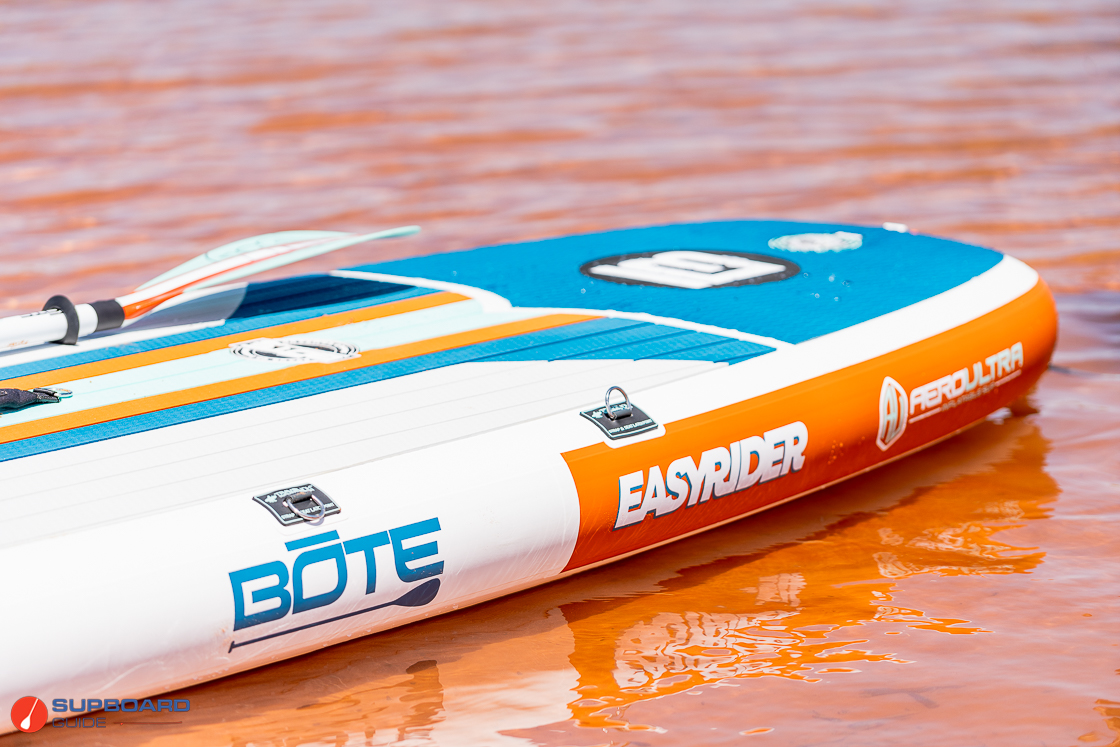
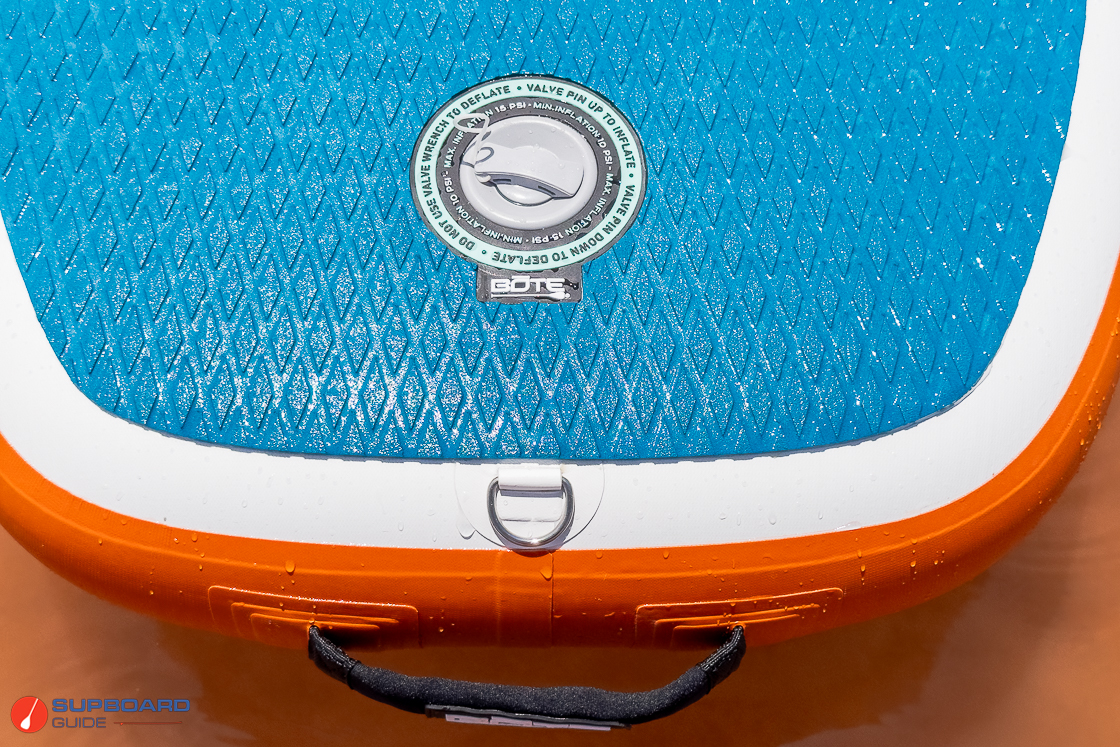
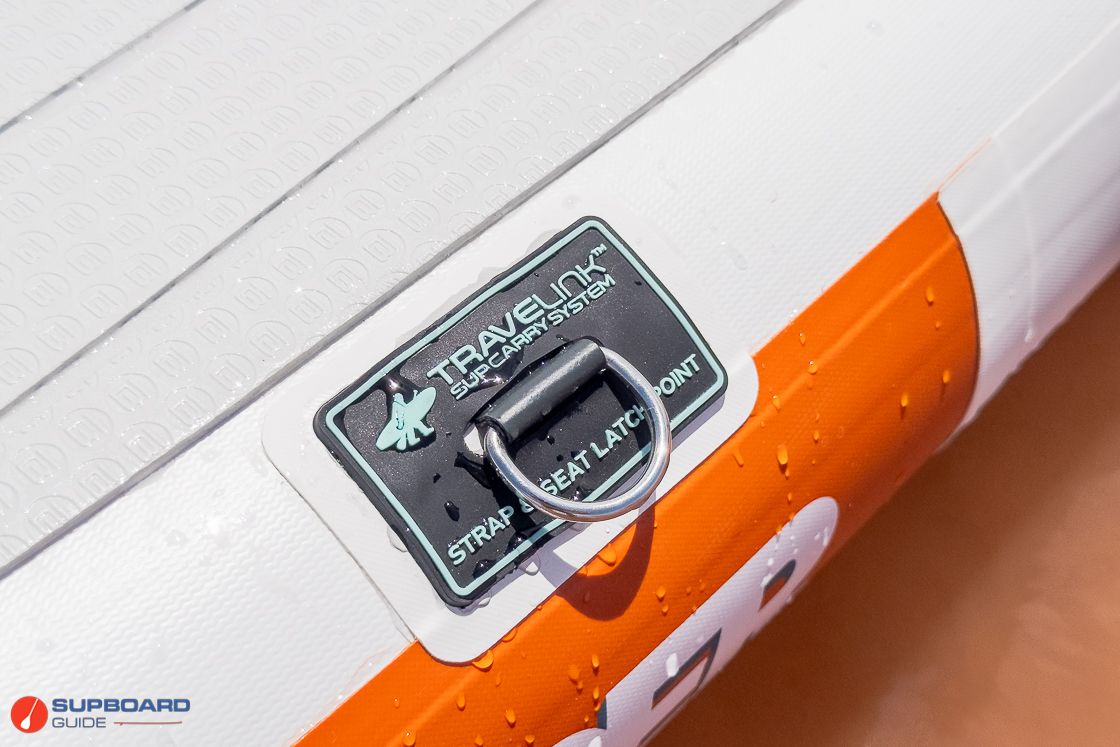
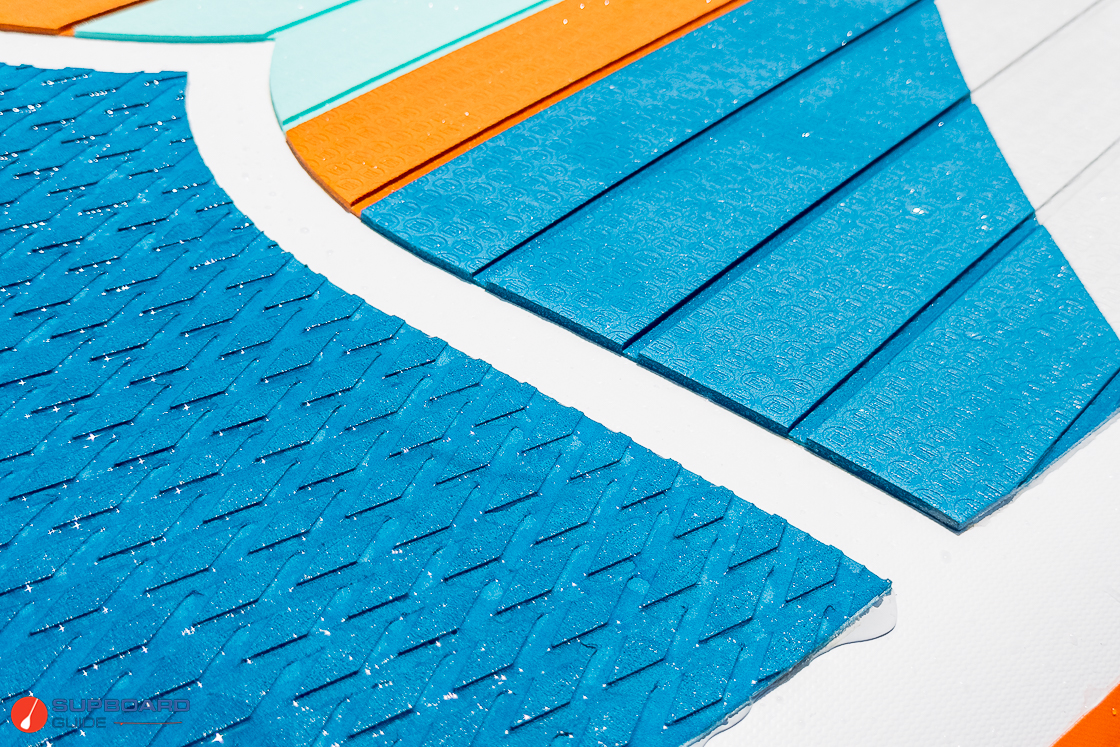
Bote’s lightweight single-layer AeroUltra construction technology, as used on the EasyRider Aero 10’4, features a single layer of PVC fused to the fabric base layer of the knitted drop stitch core. The sides of the board are created from two layers of PVC, to add additional durability to this all-important area of the board.
Single layer fusion is becoming an increasingly popular construction method, as it saves a lot of weight over the double-layer construction techniques. While it’s still somewhat more flexy in feel than double layer boards, it’s a whole lot more rigid and robust than the original single layer construction popular in the early days of inflatable boards.
Board Stiffness:

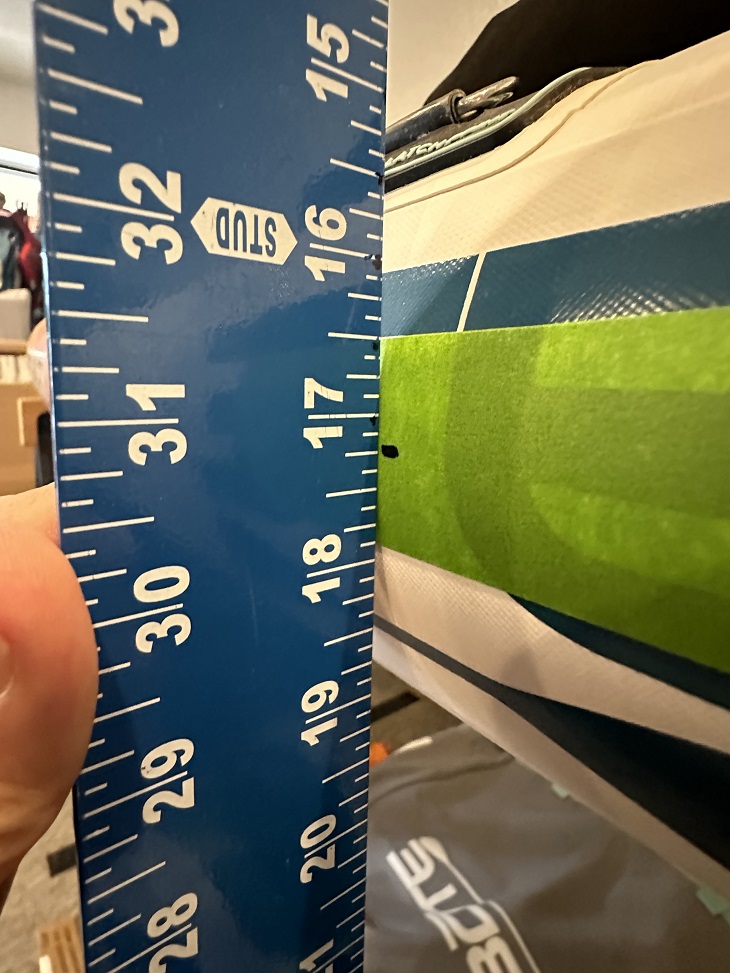
Stiffness Test: 1.75” Bend
The flex test result for the EasyRider Aero 10’4 revealed a relatively large degree of flex, as to be expected from the single layer construction. (Dual layer boards would typically have around 1” of flex, to give a comparison).
The flex test doesn’t translate exactly to how a board feels on the water. In a normal recreational cruising paddling scenario, the EasyRider Aero 10’4 feels comfortably stiff and rigid underfoot. As discussed in the Speed section earlier, it’s only when you try to crank the board along at higher speeds that you start to notice the deflection.
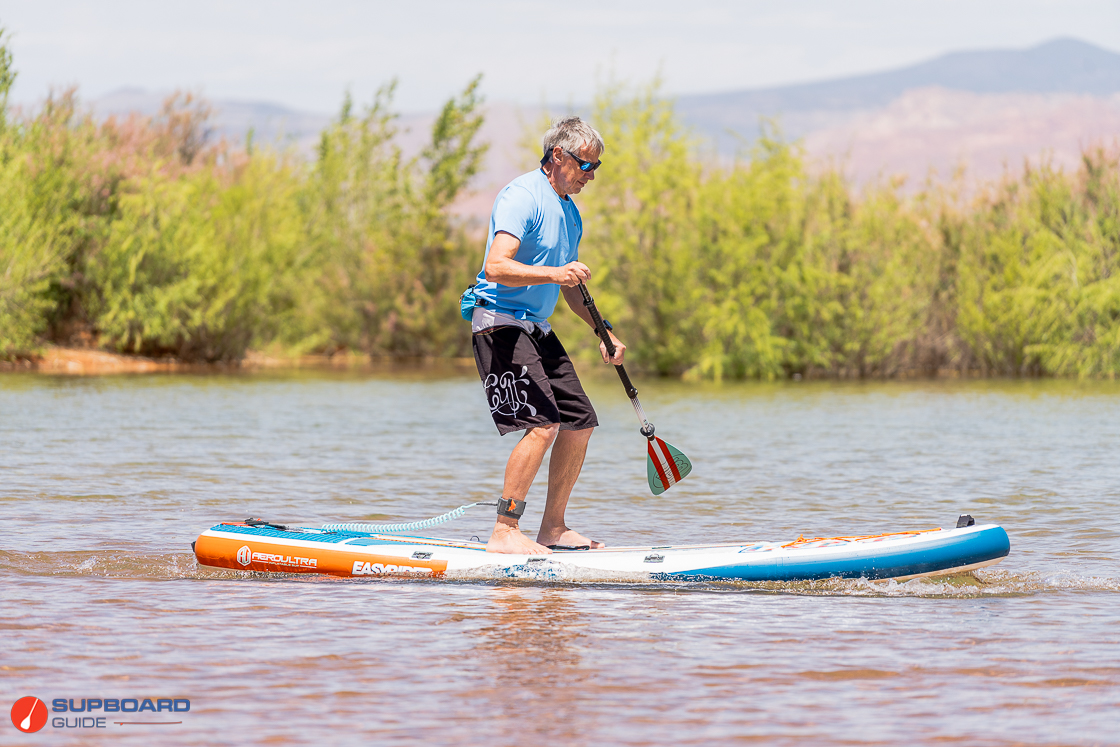
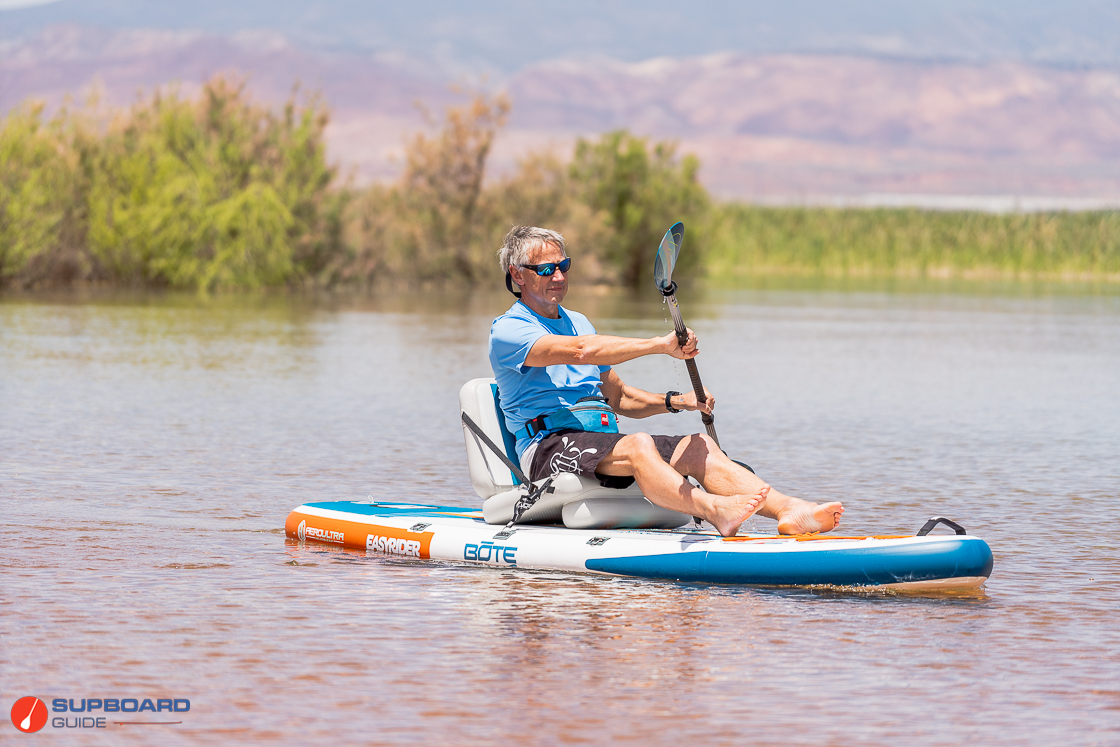
If you’re in kayak mode, with your weight spread more evenly across the surface of the board, there’s even less noticeable flex when you’re paddling.
Overall, that slight loss of performance due to the more flexy construction is more than made up for by the lighter weight. You’re not buying a board like this to win races, but a board that is lighter to carry to the water’s edge feels like a winner every time!
To ascertain the rigidity of each board we review, we use our own specific laboratory bend test process. The board is inflated to its maximum recommended PSI and then placed across two sawhorses positioned exactly 7 feet apart. We then measure the distance from the middle of the board to the floor. Then, we place a 150 lb weight on the middle top of the SUP, and measure the distance to the floor again. The difference between the two measurements shows the deflection, or ‘sag’, that the board has experienced due to the added weight. We have been reviewing the stiffness of boards using this technique since 2021 and while it isn’t an exact replication of the weight distortion that occurs when a rider stands on a SUP board in the water, it still gives a very useful comparative tool in determining the stiffness of the board’s construction process.
Features/Accessory Review: 8.7/10
Features:


First thing you notice about the Bote EasyRider Aero 10’4 is that cheery ‘Native Tides’ color scheme. The ¾ length EVA foam deck pad has various textures in different areas of the board, with longitudinal drainage grooves to move water away from the standing area, and a more aggressively embossed tail pad to give maximum grip when you’re standing back in that area.
As with so many other aspects covered in this review, the Bote EasyRider Aero 10’4 once again sits slightly outside of the norm when it comes to fittings and fixtures. In some ways it’s a little bit behind many of its competitors – there aren’t any bungee fixings on the tail, there’s no paddle holder or other cargo fixing points along the side, for example. Nor are there any action camera mounting points.
On the other hand, it’s got some really cool stuff going on, such as the Bote Magnepod accessory mount in front of the standing area, which can securely hold drink tumblers, speakers, and other accessories without needing to screw or clip anything into place.
The kayak seat and footrest mounts along each side are robust and well fixed, and double as shoulder strap attachment points. They could also very easily be modified to make into paddle mounts or for tying on extra cargo.
The board has generously proportioned carrying handles in the center and on the nose and tail. Ideally, we prefer to see the tail handle mounted on the deck rather than on the rail as Bote have done here, since a deck mounted handle is more comfortable when carrying the board, and it makes rafting up with friends on the water rather easier.
The underside of the board has just the one central fin box, with a click-in style fin that is very different to the fins being supplied by any other brand. It’s huge in area and possesses no foiling at all, which is actually quite an innovative approach and makes a lot of sense on a board that is simply not intended for faster paddling. It’s essentially a keel, just there to keep the board on track, and it does this very efficiently.
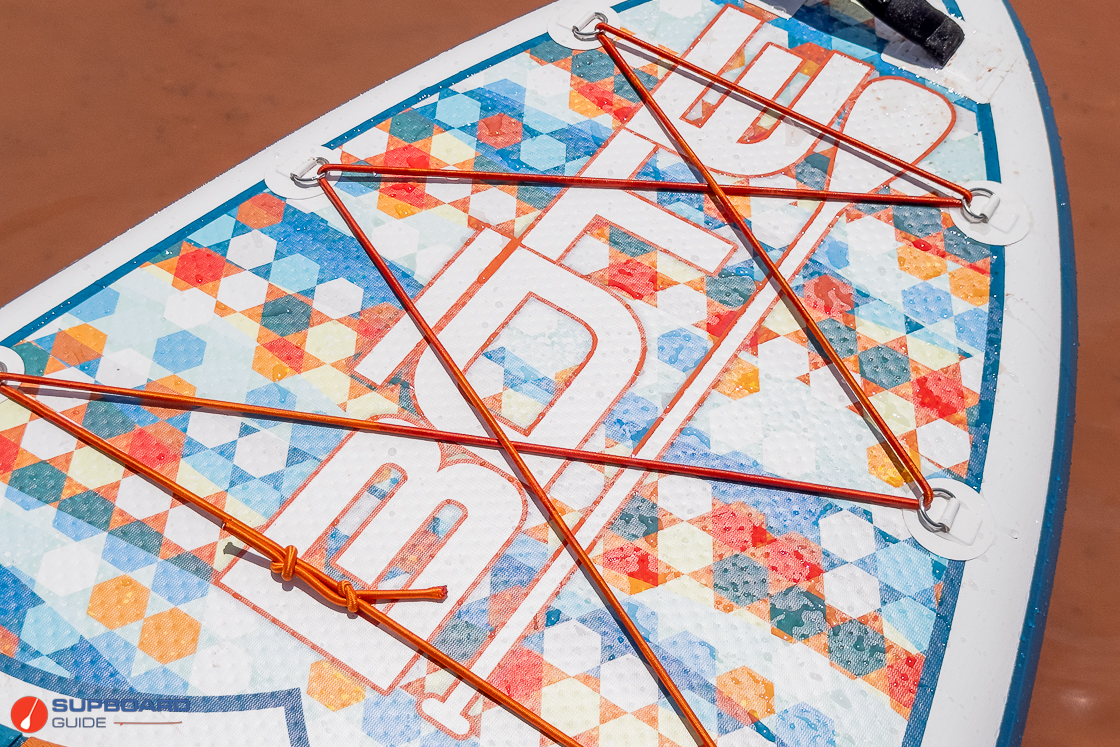

Included Accessories: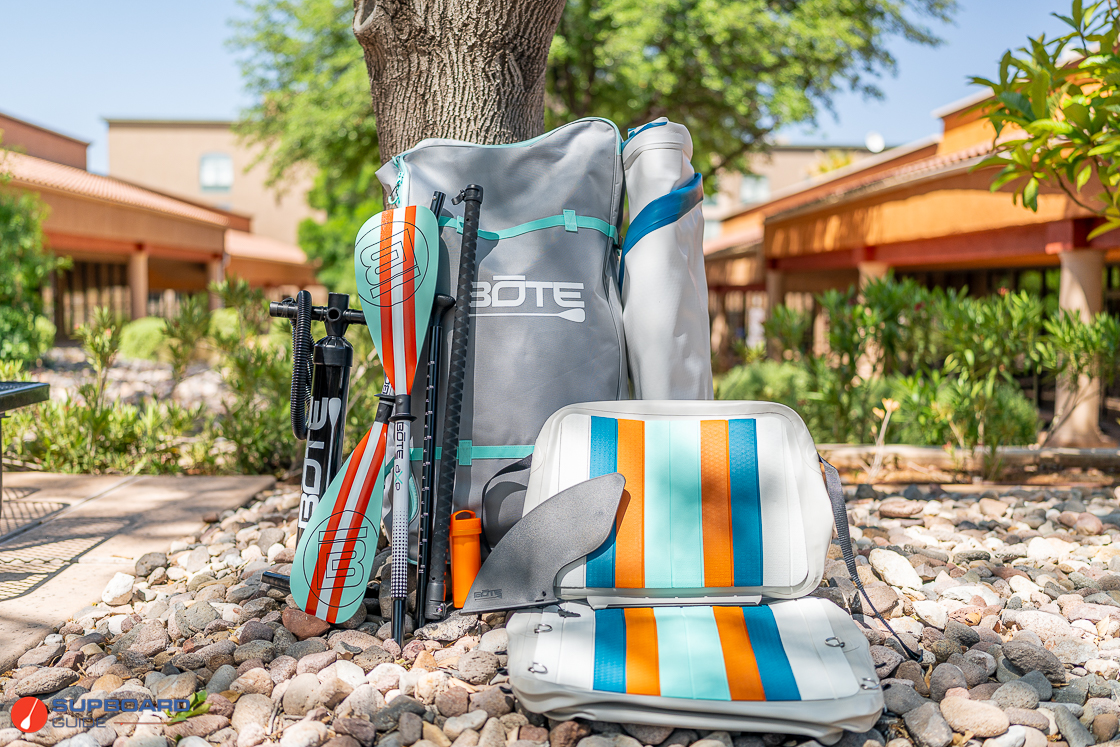
The Bote EasyRider Aero 10’4 comes complete with everything you need to go paddleboarding or kayaking, and it all fits nicely into the Bote Aero travel bag. The Aero single chamber hand pump has a deflate mode as well as inflate.
The paddle can be switched from SUP to kayak mode, by swapping the SUP handle top section for the second blade. The paddle shaft is aluminum and the blades are plastic, with quite a lot of scoop on the blade face. The central section of the paddle has an outer grip sleeve, which is nice in cooler weather as aluminum is cold to the touch, but it does add a bit of extra weight to an already relatively heavy paddle.
This Bote paddle does work perfectly well, but if you want to take your SUP or kayaking to the next level you’ll definitely benefit from upgrading. While alu paddles are tough and durable, a fiberglass/carbon paddle feels a whole lot nicer in the hands and is lighter and more responsive, allowing you to paddle further or faster with less fatigue. The Bote LowRider Solo package is pretty much the same board but with better fittings and the carbon paddle option, and the extra $150 does look like very good value.
The kayak seat works extremely well. It inflates to 10 PSI and is rock solid and very comfortable. The additional section that folds under the seat to cant it backwards works really nicely, giving a very ergonomic position to paddle from. The whole apparatus clips on very easily, and is actually so comfortable that it works well as a seat on the beach!
Summary Review of the Bote EasyRider Aero 10’4
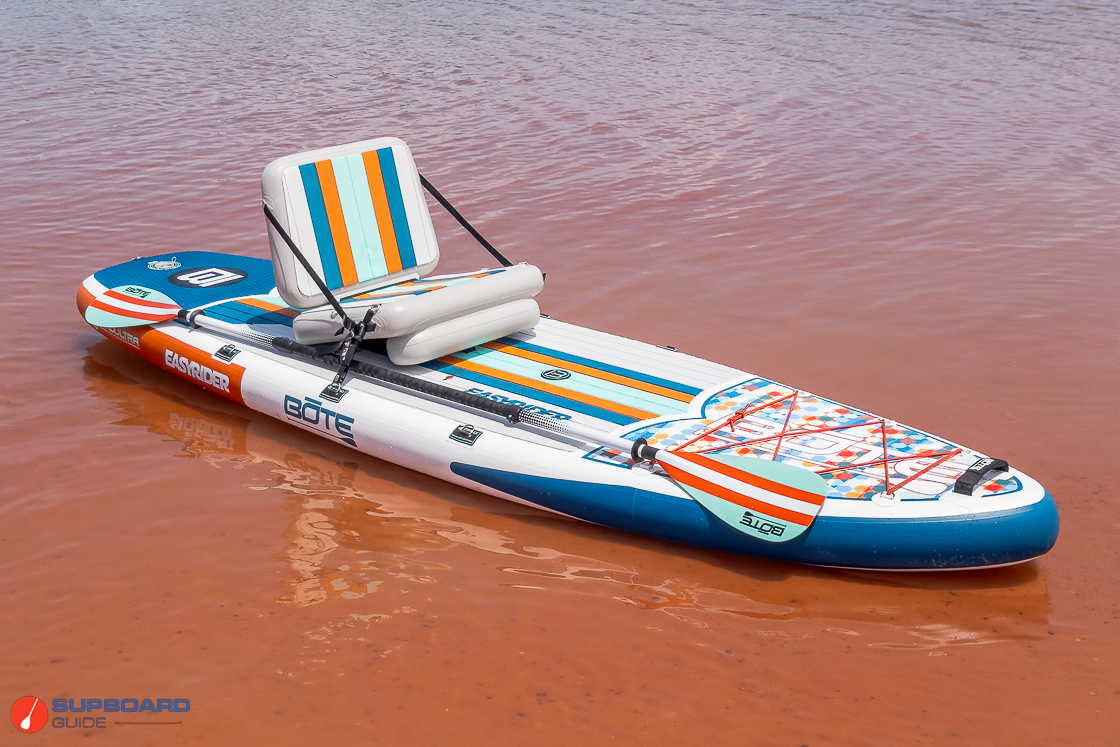
So what’s our overall take on the package? We won’t deny, we’re stand-up paddleboarders at heart, so this is where the majority of our focus remains when writing reviews on hybrids like the Bote EasyRider Aero 10’4. When it comes to the kayaking aspect, the main thing that separates the many boards now offering this hybrid facility is actually not so much the board design itself, but the quality of the kayak fittings; the seat, the footrest (or lack of), the paddle configuration, etc. And we’ve discussed these quite a bit in the previous sections of this review.
So we’ll summarize the kayaking performance of the EasyRider Aero 10’4 simply by saying that it’s very stable and gives an easy smooth ride. As for its paddleboarding performance, what we have here is a large, user-friendly, stable platform; great for anyone up to around 250 lbs wanting to learn to paddleboard, and for pretty much any typical summer fun paddleboarding usage where you’re not needing to coax too much speed out of the board.
Bote actually have several SUP/kayak hybrids in their range, so how do they compare? The EasyRider is the shortest at 10’4, and essentially the budget model in the range. However, by making it that bit shorter, they’ve actually positioned it in a slightly different place in the market to their competition. Pretty much every other hybrid out there (including the others in the Bote range) is 10’6 or longer. Whereas by going shorter and opting for the lighter weight construction, Bote has managed to keep a light and lively feel to the board, no easy feat when we’re talking about something 36” wide!
Its light weight also means that it’s easy to carry, and the generous deckpad means you could certainly get more than one person on board, or use the board in a yoga/stretching mode, or for a bit of fishing (although if this is your thing, Bote have boards in their range much more focussed on this particular activity).
So overall, we think that Bote has done a great job in creating a user-friendly entry-level hybrid package, at a decent price. The other similar hybrid in the Bote range is the LowRider 10’6, slightly heavier but offering a bit more cargo carrying capacity, a full length deckpad and a more sophisticated paddle for an extra $150, which also makes for a good value package.
Happy paddling! We hope you enjoyed this review of the Bote EasyRider Aero 10’4. If you have any questions or comments please leave us a comment below, we always love to hear from you.
SupBoardGuide
Latest posts by SupBoardGuide (see all)
- BOTE EasyRider Aero 10’4″ Native Tides Inflatable Paddle Board - April 28, 2025
- Sea Gods Diatom TEN6 CX iSUP Review – 2025 | Even More Beautiful Than Before! - April 27, 2025
- Sea Gods Skylla CX iSUP Review, 2025 - April 21, 2025

